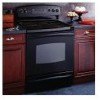GE JB910 Owners Manual - Page 4
Before, Radiantsurface, Units
 |
View all GE JB910 manuals
Add to My Manuals
Save this manual to your list of manuals |
Page 4 highlights
READALL INSTRUCTIONSBEFOREU$1N& RADIANTSURFACUENITS Use proper pan size--select cookware having fiat bottoms large enough to cover the surface unit heating element. The use of undersized cookware will expose a portion of _he surface unit to direct contact and may result in i)nifion of clothing, Proper relationship of cookware to surface unit will also improve efficiency. Never leave the surfi_ce units unattended at high heat settings. Boilove_3 cause smoking and greasy spillove_3 that may catch on fire. Only certain types of glass, glassA'eramic, earthenware or other glazed containe_3 are suitable for cooktop service; othe_ may break because of the sudden change in temperature. To minimize of flammable of a container the possibili_' of bm'ns, ignition mamfials and spillage, the handle should be turned toward the center of the range without extending over nearby sm_i_ce milts. Mwavs turn the sudi_ce units off before i'ei/loving cookware. X4]/ell preparing flaming foods tinder the hood, ttli'n the lira on. Use care when touching the cooktop. The glass sui_ilce of the cooktop will retain heat after the controls haxe been turned off. Keep an eye on foods being flie(1 at high or medium high heat settings. Foods fiw fl'ying should be as ch_' as possible. _l'ost on ll"ozen lOo(|s or illoisttli'e on fi'esh fi)ods can cause hot fi_t to bubble up and over the sides ot the pan. Use little ti_t tot effective shallow or deep ti_t fl'ying. Filling the pan too flfll of ti_t can cause spillove_ when tood is added. If a combination of oils or fats will be used in flTing, stir together before heating, or as ti_ts melt slowly. Mwavs heat ti_t slowly; and watch as it heats. Use a deep ti_t them_ometer whenever possible to prevent overheating ti_t beyond the smoking point. i_uge scratches or impacts to glass (loo_ or cooktops can lead to broken or shattered glass. Do not operate the radiant sm'ti_ce milts if the glass is broken. Spillove_ or cleaning solution may penetrate a broken cooktop and create a risk of electrical shock. Contact a qualified technician immediately should yore" glass cooktop becoi//e broken. Never use the glass cooktop SUltilce as a cutting board. ; Do not place or store items that can melt or catch fire on the glass cooktop, even when it is not being used. Be carefifl when placing spoons or other sorting utensils on glass cooktop sm'li_ce when it is in use. Thev may become hot and could C;l//se b//I'ns, Clean the cooktop with caution. If a wet sponge or cloth is used to wipe spills on a hot sm'fi_ce trait, be careflfl to avoid steam burns. Solile cleanei_ can pi'o(hlce applied to a hot surfl_ce. nOXiOUS tillIleS i[ NOTE: "We recommend that you avoid wiping any sm'fi_ce trait areas tmtil they have cooled and the indicator light has gone off. Sugar spills are the exception to this. Please see the Cleaning the glass cooktop section. \_l_en the cooktop is cool, use only the (;EI_dMA BRYTE ': Ceramic Cooktop Cleaner and the CEIL_dMA BRYTE Ceramic Cooktop Cleaning Pad to clean the cooktop. To avoid possible damage to the cooking sm'fi_ce, do not apply cleaning cream to the glass smtace when it is hot. _Mter cleaning, use a (hw cloth or paper towel to remove all cleaning cream residue. Avoid scratching the glass cooktop. The cooktop can be scratched with imms such as shaq) instruments, rings or otherjeweh> and rivets on clothing. Read and ti)llow all instructions and warnings on the cleaning cream labels. Do not use plastic wrap m cover rood. Plastic may melt onto the smthce and be very difficult to i'ei/love. 4













